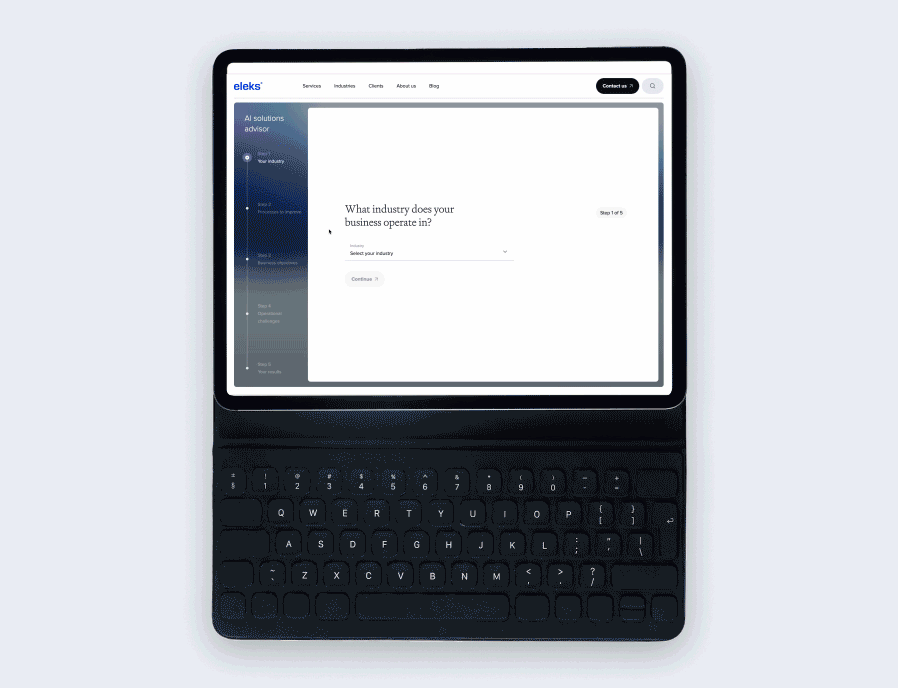Energy is crucial for industrial operations as it powers manufacturing processes, transportation systems, and infrastructure development. However, the energy sector is facing several challenges such as market volatility and restricted scalability. Moreover, due to the commitments under the Paris Agreement, the global shift towards decarbonisation requires significant changes in energy production, distribution, and consumption.
As traditional energy sources become less sustainable, energy sector companies are confronted with new operational challenges, more interconnection between markets and commodities, and challenges to their overall business models, which leads them to increasingly turn to adopt energy and power technology. By leveraging such digital solutions, these companies aim to enhance energy efficiency and accelerate the transition towards decarbonising energy systems.
We've compiled a list of the top technologies driving the transformation of the energy sector. Let's delve into how innovative technologies can help tackle challenges and contribute to market transformation.
The role and potential of AI in the energy sector
Artificial intelligence (AI) offers advanced solutions to optimise operations, improve efficiency, and drive innovation in the energy sector. With the growing complexity of energy systems and the need for sustainable practices, AI technologies are playing a crucial role in shaping the future of the industry.
As the energy system becomes more decentralised with the inclusion of numerous decentralised energy producers, the complexity of managing the grid increases. AI has come to the rescue by automating grid operations, optimising the flow of electricity, and ensuring stability and reliability. For example, AI can predict and manage power demand fluctuations, prevent blackouts, and reduce energy loss.
In addition, AI can potentially improve the accuracy of renewable energy generation forecasts. By analysing vast amounts of data, including weather patterns and historical information, AI can facilitate the integration of solar and wind energy into the grid. Furthermore, AI-powered predictive maintenance of renewable energy infrastructure can significantly reduce operational costs and increase the lifespan of assets, ensuring a more dependable energy supply.
AI is making significant contributions to the energy sector, not only by increasing operational efficiencies but also by advancing material science. Critical for developing next-generation energy technologies, such as advanced batteries and solar panels, AI enables scientists and researchers to rapidly discover and optimise new materials for energy storage and conversion. By analysing vast amounts of data on molecular structures, AI can identify promising materials faster than traditional methods, which leads to the rapid deployment of more efficient and cost-effective energy solutions.
When considering AI solutions for industrial applications, it’s essential to understand that there are different approaches to AI implementation, such as Edge AI and Cloud AI. Let’s look at the key differences between the two.
| Comparison criteria | Edge AI | Cloud AI |
|---|---|---|
| Use cases | Edge AI is perfect for scenarios requiring immediate decision-making, such as monitoring equipment or detecting anomalies on the factory floor. Edge AI is the better option when sensitive data needs to remain local and not be transmitted to the cloud. Edge AI reduces the need for constant data transfer, making it suitable for low-bandwidth environments. |
Cloud AI is adept at processing vast amounts of data, training complex AI models, and executing resource-intensive tasks. Less latency-sensitive applications benefit from cloud AI, which provides strong computational power when real-time response is not critical. |
| Advantages | Edge devices process data locally, which reduces response time due to low latency. Edge AI is capable of operating independently without the need for an internet connection. Real-time insights at the edge enable efficient decision-making. |
Cloud environments offer flexibility in design and architecture. High computational capabilities ensure that there are no restrictions on memory, size, or performance. Longitudinal insights are derived from cloud AI processing data over time, providing deeper and more comprehensive insights. |
| Considerations | Edge devices may have limitations in memory and performance due to their limited processing power. Smaller machine learning models due to restricted memory capacity. Devices can be vulnerable if not properly secured. |
Internet connectivity is required as devices need to connect to the cloud for processing. Cloud services may incur expenses. |
In general, edge AI is excellent for immediate, local decision-making, while cloud AI provides scalability and powerful computation for more complex tasks. Many enterprises combine both to maximize insights across their IT infrastructure.

Transforming energy operations with intelligent automation
Intelligent automation in the energy sector is transforming traditional operations and addressing emerging challenges, particularly those associated with efforts to reduce carbon emissions. Enhancing robotic process automation (RPA) technology with AI has the potential to streamline and automate processes across business functions—from asset management and customer operations to energy systems and enterprise operations—offering significant reductions in operational and maintenance expenses.
The impact of intelligent automation goes beyond saving costs; it improves employee experiences by freeing up resources from mundane tasks and allowing them to focus on more strategic activities. This not only increases productivity but also enhances job satisfaction among employees, creating a more innovative workplace environment.

Digital twins for enhanced energy management
Digital twins create real-time virtual replicas of physical energy systems, which enables precise monitoring, analysis, and prediction. The technology provides a deeper understanding of energy systems from power generation to consumption, promoting seamless integration of renewable resources and optimising grid performance.
- Key benefits of digital twins for the energy sector:
-
- Optimised grid management and integration of renewable energy sources. Digital twins can simulate real-time scenarios using current data to forecast energy demand and prepare the grid for fluctuations. It is particularly valuable in smart cities, where energy consumption patterns can be unpredictable due to the diverse range of technologies and applications.
- Enhanced renewable energy operations. As cities move to sustainable energy, managing the variability of renewable sources like solar panels and wind turbines becomes crucial. Digital twins predict energy output by analysing weather data and historical performance, optimising production and consumption balance, increasing reliability, and maximising energy production during peak availability.
- Improved maintenance and asset management. Digital twins continuously update virtual models with real-time data from physical components to predict potential failures and maintenance needs. Such an approach reduces downtime, extends equipment lifespan, and enhances system reliability.
The impact of IIoT on the energy industry
The Industrial Internet of Things (IIoT) is significantly transforming the energy sector by driving efficiencies and pioneering new approaches to power management. This transformation is fueled by the integration of advanced sensor technology, big data capabilities, and analytics. These advancements optimise operations and introduce innovative business models that challenge traditional industry norms.
IIoT powered by AI technology can be used to manage energy consumption more efficiently. It can analyse usage patterns and adjust energy consumption in real time in buildings, factories, and homes. This can reduce energy costs for consumers and help balance the grid by shifting demand to match the availability of renewable energy. For instance, AI-enhanced IIoT sensors can manage the charging of electric vehicles and take advantage of periods when renewable energy supply is high. It boosts the use of green energy and reduces peak load pressures on the grid.
In addition, IIoT can improve worker safety in the energy sector through remote monitoring, reducing risk to operators and enabling early hazard identification for maintenance without endangering personnel.
Leveraging the cloud in the energy industry
Transitioning to cloud-based systems can help energy companies break down the traditional silos that have decreased efficiency and innovation. The cloud enables smooth integration across various operational areas, from customer management to daily functions, enabling instant data sharing and decision-making.
Moreover, the scalability of cloud computing allows energy firms to adjust their computing resources dynamically, matching the fluctuating needs of the energy market. This flexibility is vital for managing the cyclical nature of energy demand, particularly as the sector moves towards more sustainable energy sources and technologies.
Advanced cloud solutions enable real-time monitoring and management of energy consumption and emissions, facilitating more sustainable operations.
Technology application in energy industry
Digital technologies can enhance supply, transmission, and balance resilience by leveraging predictive analytics, real-time monitoring, and advanced threat detection.
It can integrate consumer technologies into the energy value chain, enabling real-time monitoring, smart grids, and enhanced energy efficiency.
Technologies can facilitate progress reporting by providing real-time data analytics, performance monitoring, and reporting tools. These tools enable organisations to track their progress towards decarbonisation and sustainability goals.
Conclusions
As we explore the impact of digital solutions in the energy sector, it's clear that integrating technologies is not only improving operational efficiency, but also creating a more sustainable and resilient energy landscape. These technologies play a crucial role in meeting growing energy demands while aligning with global sustainability goals. Whether it's optimising grid operations, reducing emissions, or introducing new business models, the potential of energy and power technology is limitless.

FAQs
Energy and power technologies cover a broad range of innovations and systems aimed at generating, distributing, and managing energy in a more efficient and sustainable manner. These technologies encompass traditional methods like fossil fuel-based power plants and hydroelectric systems, as well as modern advancements such as renewable energy sources, smart grids, and energy storage solutions.
Power technology refers to the various methods and systems used to generate, transmit, distribute, and manage electrical power.
Related Insights







The breadth of knowledge and understanding that ELEKS has within its walls allows us to leverage that expertise to make superior deliverables for our customers. When you work with ELEKS, you are working with the top 1% of the aptitude and engineering excellence of the whole country.

Right from the start, we really liked ELEKS’ commitment and engagement. They came to us with their best people to try to understand our context, our business idea, and developed the first prototype with us. They were very professional and very customer oriented. I think, without ELEKS it probably would not have been possible to have such a successful product in such a short period of time.

ELEKS has been involved in the development of a number of our consumer-facing websites and mobile applications that allow our customers to easily track their shipments, get the information they need as well as stay in touch with us. We’ve appreciated the level of ELEKS’ expertise, responsiveness and attention to details.


